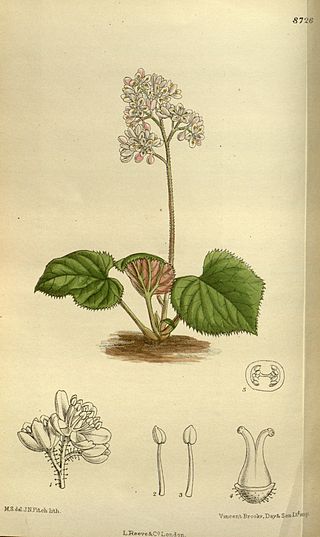
Royal Botanic Gardens, Kew is a non-departmental public body in the United Kingdom sponsored by the Department for Environment, Food and Rural Affairs. An internationally important botanical research and education institution, it employs 1,100 staff. Its board of trustees is chaired by Dame Amelia Fawcett.

Saxifraga is the largest genus in the family Saxifragaceae, containing about 473 species of holarctic perennial plants, known as saxifrages or rockfoils. The Latin word saxifraga means literally "stone-breaker", from Latin saxum + frangere. It is usually thought to indicate a medicinal use for treatment of urinary calculi, rather than breaking rocks apart.

Linaceae is a family of flowering plants. The family is cosmopolitan, and includes about 250 species in 14 genera, classified into two subfamilies: the Linoideae and Hugonioideae. Leaves of the Linaceae are always simple; arrangement varies from alternate to opposite or whorled. The hermaphroditic, actinomorphic flowers are pentameric or, very rarely, tetrameric.

Hesperocyparis arizonica, the Arizona cypress, is a North American species of tree in the cypress family Cupressaceae, native to the southwestern United States and Mexico. Populations may be scattered rather than in large, dense stands.

Monardella is a genus of approximately 40 species of annual and perennial plants native to western North America from British Columbia to northwestern Mexico. They are grown for their highly aromatic foliage, which in some species is used for herbal teas. The two-lipped, tubular flowers are formed in terminal clusters and are most usually red, pink, or purple.

Linnaea is a plant genus in the honeysuckle family Caprifoliaceae. Until 2013, the genus included a single species, Linnaea borealis. In 2013, on the basis of molecular phylogenetic evidence, the genus was expanded to include species formerly placed in Abelia, Diabelia, Dipelta, Kolkwitzia and Vesalea. However, this is rejected by the majority of subsequent scientific literature and flora.

Castilleja exserta is a species of plant in the genus Castilleja which includes the Indian paintbrushes. Its common names include purple owl's clover, escobita, and exserted Indian paintbrush.

Myodocarpaceae is a family of flowering plants which contains 2 genera and 15 species. The family is accepted under the APG IV system and placed in the order Apiales. In earlier systems the two genera were included among the Araliaceae.

The family Apodanthaceae comprises about 10 species of endoparasitic herbs. They live in the branches or stems of their hosts, emerging only to flower and fruit. The plants produce no green parts and do not carry out any photosynthesis. There are two genera: Pilostyles and Apodanthes. A third genus, Berlinianche, was never validly published. Mitochondrial and nuclear DNA sequences confidently place the Apodanthaceae in the Cucurbitales, where they also fit well in terms of their flower morphology. The native range of Apodanthes is restricted to Central and tropical South America, while Pilostyles has a much wider though disjointed native range, encompassing many countries in tropical and subtropical America, a section of Africa from Gabon to Tanzania and down to Zimbabwe, as well as Turkey, Iran, Iraq, and Western Australia.
Plants of the World Online (POWO) is an online database published by the Royal Botanic Gardens, Kew. It was launched in March 2017 with the ultimate aim being "to enable users to access information on all the world's known seed-bearing plants by 2020". The initial focus was on tropical African Floras, particularly Flora Zambesiaca, Flora of West Tropical Africa and Flora of Tropical East Africa.
Garcinia binucao is a species of flowering plant in the Clusiaceae family. It is commonly known as binukaw or batuan, is a species of Garcinia endemic to the Philippines. It is not cultivated, though its edible fruits are harvested from the wild for use as a souring agent in some Filipino dishes.

Prestoea acuminata is a species of palm tree native to Central America, the West Indies and South America.
Archiatriplex nanpinensis is a species of flowering plant belonging to the family Amaranthaceae. It is an annual endemic to northern Sichuan province of south-central China. It is the sole species in genus Archiatriplex.
Conimitella williamsii is a species of flowering plant belonging to the family Saxifragaceae. It is the sole species in genus Conimitella. It is a perennial native to Alberta in west-central Canada and to Idaho, Montana, Wyoming, and Colorado in the northwestern United States.
Kaufmannia semenovii is a species of flowering plant belonging to the family Primulaceae. It is the sole species in genus Kaufmannia. It is native to Kazakhstan and Kyrgyzstan in Central Asia.
Microgynoecium tibeticum is a species of flowering plant belonging to the family Amaranthaceae. It is the sole species in genus Microgynoecium. It is an annual native to Central Asia, the Himalayas, Tibetan Plateau, and northwestern China.

Oresitrophe rupifraga is a species of flowering plant belonging to the family Saxifragaceae. It is the sole species in genus Oresitrophe. It is a perennial native to northern China, ranging from eastern Shanxi Province to western Liaoning Province.
Pisoniella is a monotypic genus of flowering plants belonging to the family Nyctaginaceae. It only contains one known species, Pisoniella arborescens(Lag. & Rodr.) Standl.

Elmera racemosa is a species of flowering plant belonging to the family Saxifragaceae. It is the sole species in genus Elmera.

Oreobliton is a monotypic genus of flowering plants belonging to the family Amaranthaceae. The only species is Oreobliton thesioides.












